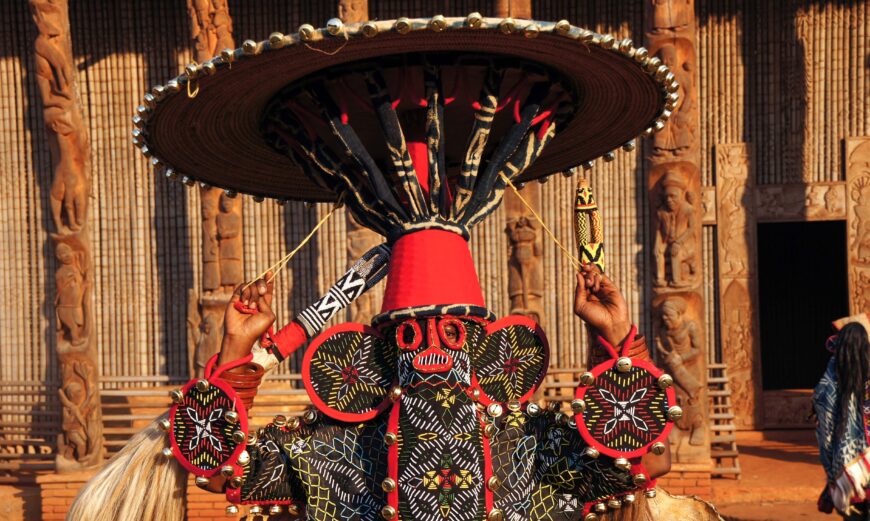
Masque d’éléphant (elephant mask) performed by dancer, Bamileke, Cameroon, 2011 (photo: Prosper Pérez, CC BY-SA 4.0)
What comes to mind when you think of masks? For some of you, a first thought might be of the masks that many people donned during the COVID-19 pandemic. Others might think of health professionals who wear masks while caring for patients in a hospital or dentist office, or other professionals who wear them while working with hazardous chemicals or construction materials. Some likely associate masks as part of costumes people wear for holidays like Halloween or Mardi Gras. Others perhaps connect masks with comic book characters or superheroes, such as Batman and Spider-Man. Lastly, some might associate masks with drama and theater, or with the titular character in Andrew Lloyd Webber’s musical, The Phantom of the Opera. In all these examples, masks usually refer to some sort of facial covering.
In African contexts however, the terms “masquerade” and “mask” are generally more inclusive and have various, yet interrelated meanings, and refer to much more than a facial covering. Firstly, masquerades are private or public performances that are not just visual in nature; they are multi-sensory experiences that consist of dance, music, and audience participation. Art historian Suzanne Preston Blier points out that “in African art, as with so many other forms, Westerners have historically privileged visual attributes, which encouraged a rather limited appreciation of the experiential power that these works hold.” [1]
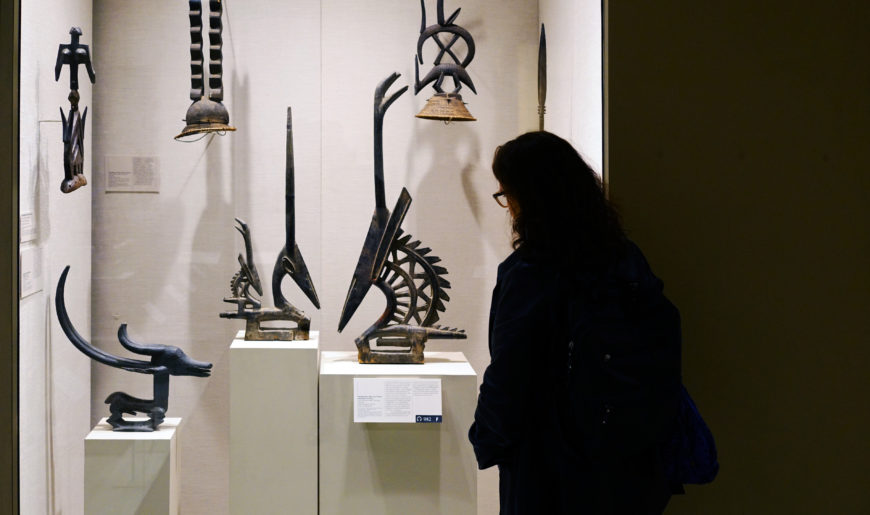
Ci wara kun (Male and Female Antelope Headdresses), 19th–20th century, Bamana peoples, wood, 90.7 x 40 x 8.5 cm, Segou region, Mali (The Metropolitan Museum of Art)
Secondly, masquerades refer to the masquerade characters that appear in the performances. These masquerade characters are called masks, and they are animated by individuals (often referred to as masqueraders, maskers, performers, or dancers) that represent, portray, or embody a variety of entities, including but not limited to deities, spirits or other supernatural forces, ancestors, living humans, personalities, and animals (such as antelopes and elephants). It is important to note that not everyone can perform as a mask.
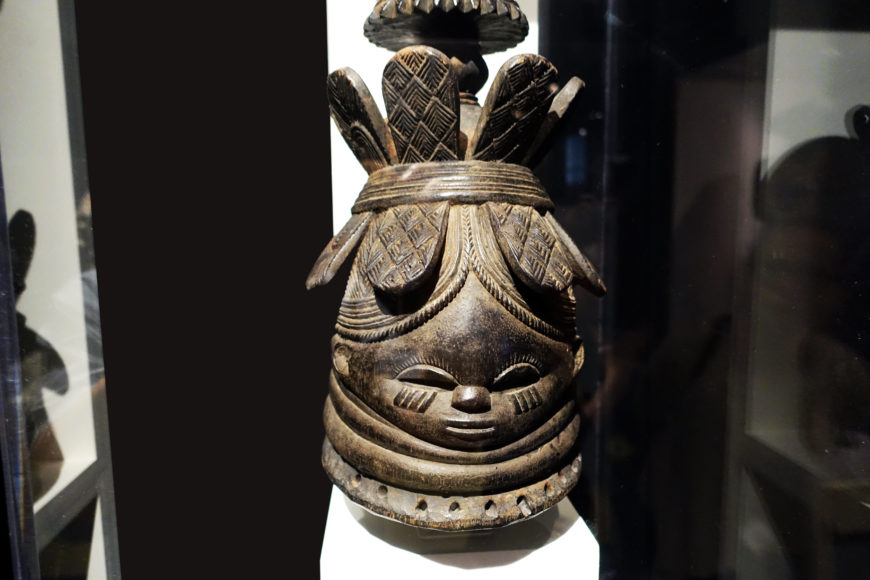
Bundu or Sowei Helmet Mask (Ndoli Jowei), Mende, Nguabu Master (Moyamba district, Sierra Leone), late 19th–early 20th century, wood and pigment, 39.4 x 23.5 x 26 cm (Brooklyn Museum)
In most documented African masquerade performances, only men who have been trained or initiated into a certain society can perform as masks. The sowei mask is the most-well known documented instance in which initiated women of the Sande society perform as masks.
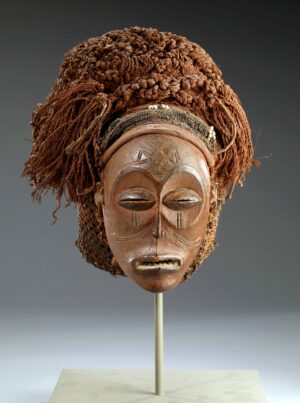
Mwana Pwo, 1920–30, Chokwe, wood, vegetable fiber, glass beads, metal, 10 1/2 x 10 1/2 in. (26.67 x 26.67 cm) (headdress), Angola or Democratic Republic of Congo (Minneapolis Institute of Art)
In many masquerade performances, the identities of the mask performers are concealed with facial coverings or headpieces and costumes. In some instances, these do not completely cover the mask performers, so their identities are not entirely concealed from the audiences. In other cases, masks might not even have a facial covering or headpiece. So as you can see, unlike the examples in the opening paragraph, the term “mask” in an African context does not simply mean a facial covering or headpiece; it also includes the costume and accessories. Although masks are performed by people, audiences generally will not regard or treat masks the same way that they would treat other people. While audiences might interact with masks through dance, song, and speech (praises or taunts), audiences usually will not touch masks because they are seen as dangerous. Touching masks is believed to cause illness, injury, or other misfortunes. For example, if the mask, Mwana Pwo, touches a person, it is believed among the Chokwe people that the individual can become sick, infertile, or suffer some mishap.
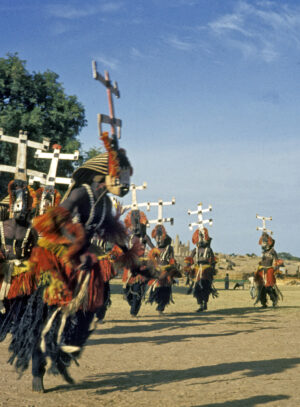
Kanaga masks performed by dancers, Dogon peoples, Mail, 1974 (photo: H. Grobe, CC BY-SA 3.0)
Masquerade performances and characters are prevalent throughout Africa, and they are diverse and unique to their social, cultural, historical, and geographical contexts. Masks can have a wide range of meanings and functions, usually appearing during certain events, including but not limited to festivals, carnivals, initiations, weddings, holidays, coronations or installations of leaders, funerals and burials, and political events, as well as for tourism. For instance, kanaga masks perform for a funerary rite for deceased men among the Dogon peoples. This rite, known as dama, helps the spirits of the deceased men make it to the world of the ancestors. While kanaga masks primarily appear at dama, they also perform during national holidays and for tourists.
Masquerade performances and characters do not remain the same over time. Rather, societies associated with masquerades, mask makers, and mask performers are dynamic and innovate to respond to communal or outside influences. For instance, the Sala Mpasu people of the Democratic Republic of the Congo developed a reputation for being savage and fierce “cannibals” to keep away neighboring peoples and Belgian colonists. This image was projected by the men’s society and their associated masquerades. While their reputation helped to ward off intruders for two centuries, it eventually became an obstacle to economic growth in the latter half of the 20th century, as people were afraid of the Sala Mpasu. To reinvent their image, the Sala Mpasu publicly announced that the men’s society and masquerading would come to an end. In reality, the men’s society and masquerades were re-shaped and associated with le Scouts, a “nationally recognized and government-sponsored organization similar to the Boy Scouts,” to become more widely accepted. [3]
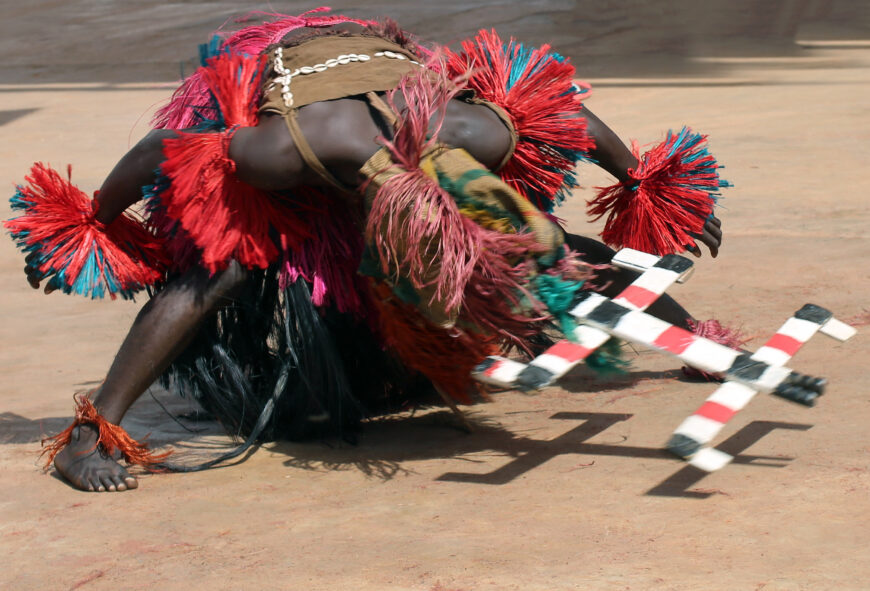
Kanaga mask performed by dancer, Dogon peoples, Mali, 2016 (photo: JDDBOSS, CC BY-SA 4.0)
Display of Masks in Museums
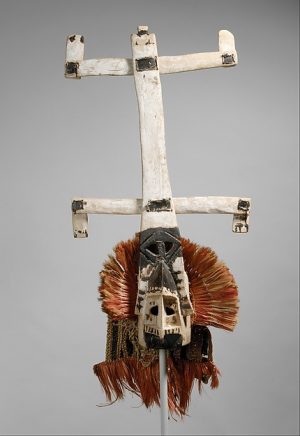
Mask (Kanaga) as typically displayed in a museum, Mali, Dogon peoples, 20th century, wood, fiber, hide, pigment, 53.6 x 97.2 x 15.9 cm (The Metropolitan Museum of Art)
Typically, when a visitor sees an African mask in a museum or gallery setting, the visitor only sees a facial covering or headpiece. The absence of the accompanying costumes and accessories erroneously suggests that the facial covering or headpiece is the most valuable and significant component of a mask performer’s ensemble. Speaking of Lo Gue, which literally translates to “white masks,” art historian Lisa Homann reminds us that, “The headpiece, often privileged in art historical discourse, is not more important than the rest of the white mask’s body.” [3]
The display of the mask in the museum or gallery space often points to colonial collecting preferences and practices, and assumptions about the primacy of the facial covering or headpiece. However, the facial covering or headpiece cannot replicate the complexity and richness of masquerade performances and characters. Museums tend to isolate the facial covering or headpiece, divorcing it from its costumes, accessories, dances, music, performers, and audience. The drama, dynamism, and movement are missing. The mask in a museum or gallery setting is not performed by a dancer, giving a visitor only an incomplete and insufficient view of masquerades. As an Igbo proverb makes plain, “The world is like a mask dancing. If you want to see it well you do not stand in one place.” [4]




